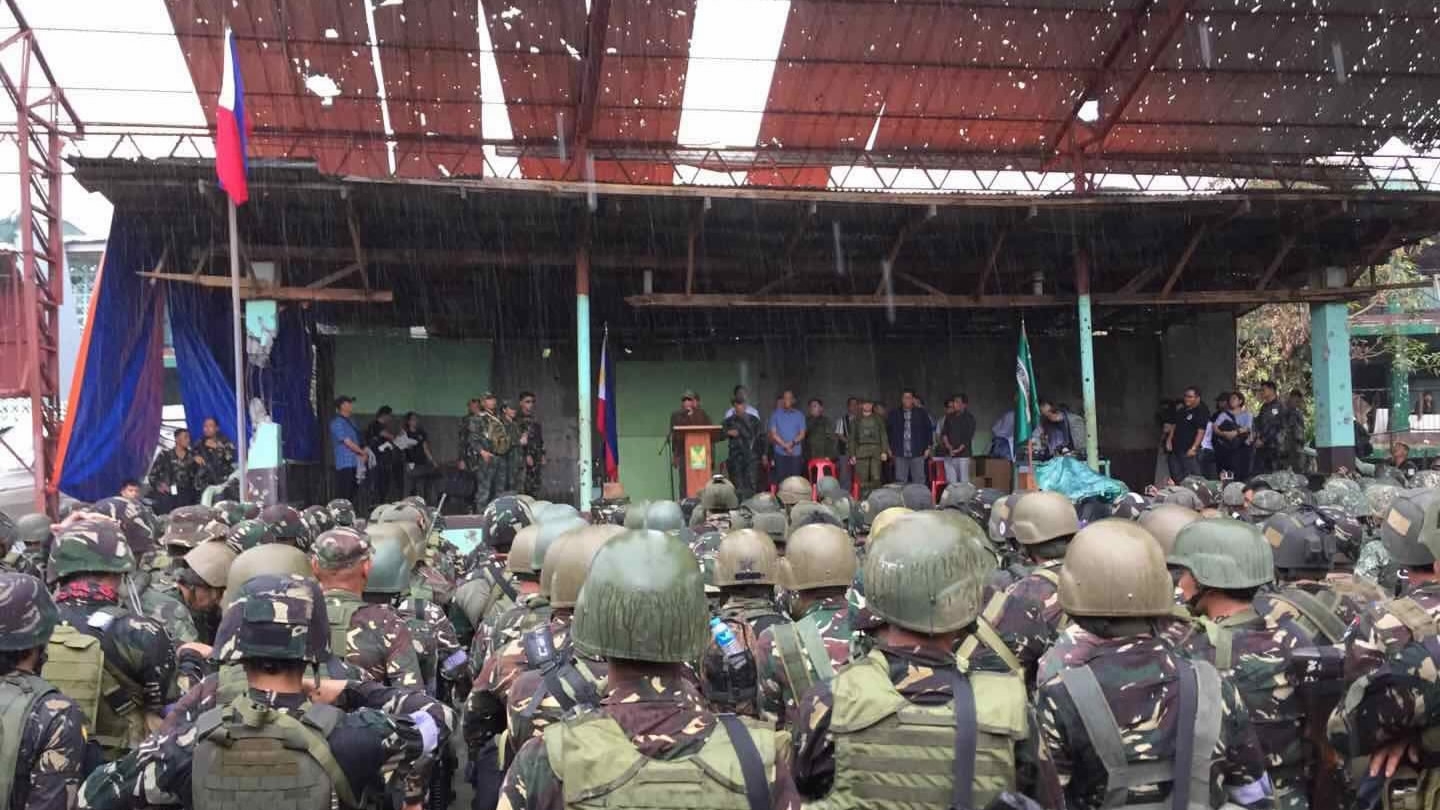
World
18:55, 19-Oct-2017
Philippine government rolls out rehabilitation plans for war-torn Marawi
April Espejo

Last Tuesday was freedom day for Philippine’s southern city of Marawi as President Rodrigo Duterte declared the city liberated from terrorists.
Now, it's time for the government to start the rehabilitation of the mostly-Islamic city after five months of battle against ISIL-affiliated militants that have claimed more than 1,000 lives and displaced 400,000 people – the biggest displacement in Philippine history not caused by a natural disaster.
And it won’t come cheap.
The cost of rebuilding Marawi

Philippine President Rodrigo Duterte announces the liberation of Marawi from terrorists in front of the troops, October 17, 2017. /Reuters
Philippine President Rodrigo Duterte announces the liberation of Marawi from terrorists in front of the troops, October 17, 2017. /Reuters
According to local media, Defense Secretary Delfin Lorenzana estimated that the government will need 10 billion pesos (around 200 million US dollars) for next year’s full rehabilitation of Marawi. Budget Secretary Benjamin Diokno, however, said that officials have yet to determine actual figures but are assured that the government has sufficient funds for the rehabilitation works.
Five billion pesos (around 100 million US dollars) from the national risk reduction fund this year has already been allotted for the initial work. The government is also set to issue its planned Marawi bond in the first quarter of 2018.
“We will not be constrained by funding,” Diokno said in earlier interviews, adding that groups like the World Bank have committed to help in the rehabilitation.
“We expect to hit the ground running on rehabilitation in the next few weeks,” he said. “Now is the time to move forward and rebuild Marawi into the inclusive, inter-faith, international and modern city it deserves to become,” Diokno added.
Lawmakers also urged immediate passage of two house bills – one that will allocate 10 billion pesos as supplemental budget for Marawi and the other to protect internally displaced persons (IDPs) because of the war.

Government soldiers stand guard in front of damaged building and houses in Marawi, Philippines September 13, 2017. /Reuters
Government soldiers stand guard in front of damaged building and houses in Marawi, Philippines September 13, 2017. /Reuters
Meanwhile, President Duterte created Task Force "Bangon Marawi" to spearhead activities in the war-torn city. Chaired by the defense secretary, the task force on Monday already sent out five teams to assess the damage in the city’s 24 barangays (villages).
The Department of Public Works and Highways (DPWH), the sub-committee of the lead agency for reconstruction, said road concreting in the development area will be completed by November. “Our priority is to make sure that roads and bridges are in place such that there is smooth access of (sic) Marawi and its nearby towns,” DPWH Secretary Mark Villar said in a local media interview.
Marawi Memorial?
Felino Palafox Jr., an architect and urban planner who committed to help rebuild Marawi has suggested to provincial officials to make the ruins of Marawi a historic memorial as a reminder of how terrorism destroyed the peaceful city.
In an interview with Philippine Daily Inquirer, Palafox said he “believe[s] the ground zero should be preserved as a lesson for future generations.”
Palafox said the recommendation had been “accepted in principle” by local officials but “their only concern was social acceptance.”

A soldier stands by damaged buildings and debris in Marawi. /Reuters
A soldier stands by damaged buildings and debris in Marawi. /Reuters
“Rehabilitate, maybe, the places of worship, education and the significant buildings. The damaged ones, they can be retained, especially those full of bullet [holes] as a lesson for the future on how terrorism can destroy a peaceful city,” Palafox said.
Intense fighting and numerous airstrikes brought extensive damage to the city. Palafox estimated that it might take 70 years to restore Marawi back to its former glory.
China's help
Even before its liberation, China had sent 47 sets of heavy equipment to help with the rehabilitation of Marawi. DPWH Secretary Villar confirmed the arrival of the equipment last week which includes eight sets of excavators, wheel loaders, dump trucks, cement mixers and five sets each of compactors, track-type tractors, bulldozers and a container van. The government said it is expecting seven more sets to arrive from China as part of the country’s Emergency Humanitarian Assistance Program.
Chinese Foreign Ministry Spokesperson Lu Kang, in a press conference on Tuesday, said “China stands ready to continue providing needed support and assistance in light of the needs” of the Philippine government on rebuilding Marawi.
“The Chinese side sincerely hopes that the people in Marawi and the Mindanao region can enjoy the peaceful and tranquil life again at an early date,” Lu said.

Philippine soldiers on board armored personnel carriers move past damaged buildings in the Mapandi area of Marawi/AFP Photo
Philippine soldiers on board armored personnel carriers move past damaged buildings in the Mapandi area of Marawi/AFP Photo
In June, Chinese Ambassador to the Philippines Zhao Jianhua handed the government a 15-million-peso check for relief operations in Marawi.
Also in June, China donated 370 million pesos worth of rifles and ammunition to help the military in fighting the terrorists.
As of September, China’s donation reached 85 million pesos, of which 70 million is intended for helping the wounded soldiers.
“Combating terrorism is the shared responsibility of all nations,” Lu said.
Other countries also pledged help: Australia has pledged one billion pesos, the United States said it would give 730 million pesos, Japan and Thailand have pledged 100 million pesos each, while European Union will donate 49 million pesos.

SITEMAP
Copyright © 2018 CGTN. Beijing ICP prepared NO.16065310-3
Copyright © 2018 CGTN. Beijing ICP prepared NO.16065310-3